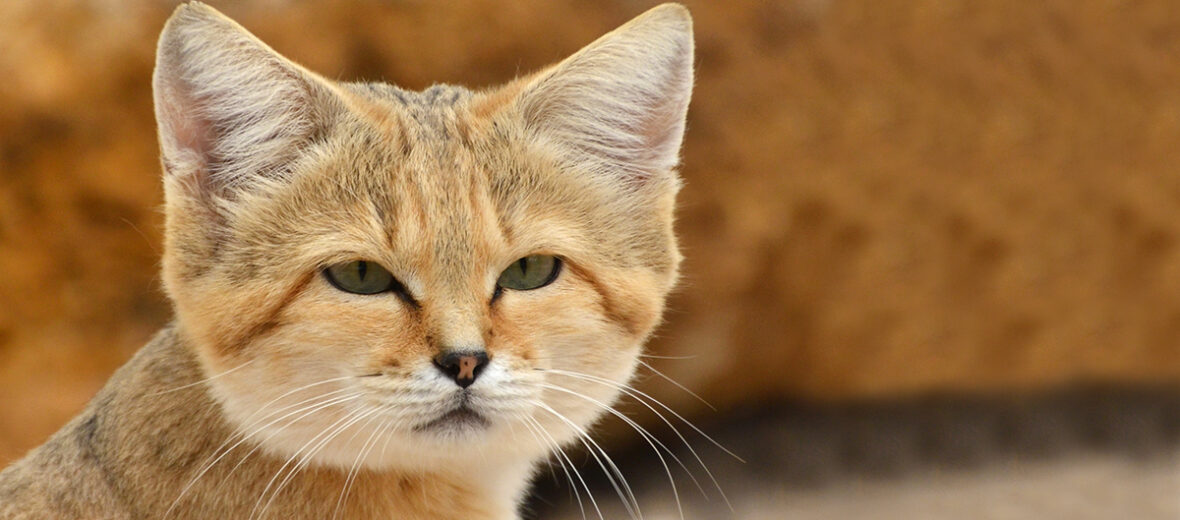
The sand cat, aka Sahara cat or sand dune cat, can be found throughout northern Africa, the Arabian Peninsula, and southwest & central Asia. They prefer stony, arid, and sandy desert biomes with little vegetation or water. Even though they face the threats of habitat destruction and loss at the hands of residential and commercial developments as well as agriculture; hunting; trapping; invasive species (and with them disease, competition for food, predation, and interbreeding); and climate change (resulting in severe droughts), these little kitties are still listed as Least Concern by the IUCN. Their population trend is unknown.
First the Stats…
Scientific name: Felis margarita
Weight: Up to 7.5 lbs.
Length: Up to 22.5 inches, plus up to a 14 inch tail
Height: Up to 12 inches, at the shoulders
Lifespan: Up to 13 years
Now on to the Facts!
1.) Sand cats were first described in 1858 and discovered in the Algerian Sahara.
2.) They have thick fur on their feet. It is thought that this aids in keeping them warm on colder nights and helps to keep them from burning their feet on the hot desert sand.
3.) The Tuareg people of the Ténéré desert tell tales of these cats being expert hunters of venomous snakes.
4.) Like most cats, they are solitary and only come together to mate.
5.) These felines also mark their territory via scratching and scent marking.
But wait, there’s more on the sand cat!
6.) Contrary to other cats, they are not good climbers or jumpers, but they can dig burrows with the best of them.
7.) Sand cats are nocturnal (active at night).
Did you know…?
These kitties can run at speeds of up to 24.85 mph.
8.) They have been documented traveling over 6 miles to find a meal!
9.) While normally producing sounds similar to house cats, they also let out loud, high-pitched barking sounds when looking for a mate.
10.) A group of cats is called a clowder, clutter, destruction, or pounce.
But wait, there’s still more on the sand cat!
11.) Mice, rats, hares, birds, reptiles, and also insects are all on the menu.
12.) Females undergo up to a 63 day gestation (pregnancy) that yields up to 4 kittens.
Did you know…?
They have evolved to obtain most of their needed water from the foods they eat and thus consume very little standing water.
13.) Kittens are independent at around 8 months.
14.) In an effort to avoid eyeshine, when humans approach them at night, they have been known to close their eyes and blend in with their surroundings.
15.) Leftover kills are typically buried in the sand for later consumption.
But wait, there’s still a little more on the sand cat!
16.) These cats can tolerate temperatures of over 104°F.
17.) Their large ears and pinnae (ear flaps) afford them with the ability to detect even the faintest sounds of their prey or predators.
18.) Due to their overly furry paws, they tend to leave no trailing footprints behind, while traversing the desert sands.
19.) Jackals, wolves, caracals, birds of prey, larger snakes, and humans prey on sand cats.
20.) Domestic and feral dogs and cats can sometimes spread diseases, like parvovirus and more to sand cats.
Now a Short Sand Cat Video!
Be sure to share & comment below! Also, check out the Critter Science YouTube channel. Videos added regularly!
Want to suggest a critter for me to write about? Let me know here.
Some source material acquired from: Wikipedia & IUCN
Photo credit: Clément Bardot



